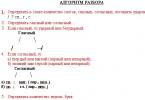Catalog of tasks.
Tasks D13. A magnetic field. Electromagnetic induction
Take tests on these tasks
Return to task catalog
Version for printing and copying in MS Word
An electric current was passed through a light conducting frame located between the poles of a horseshoe magnet, the direction of which is indicated by arrows in the figure.
Solution.
The magnetic field will be directed from the north pole of the magnet to the south (perpendicular to the side AB of the frame). The sides of the frame with current are acted upon by the Ampere force, the direction of which is determined by the left-hand rule, and the magnitude is equal to where is the current strength in the frame, is the magnitude of the magnetic induction of the magnet field, is the length of the corresponding side of the frame, is the sine of the angle between the magnetic induction vector and the direction of the current . Thus, on the AB side of the frame and the side parallel to it, forces will act that are equal in magnitude but opposite in direction: on the left side “from us”, and on the right side “on us”. The forces will not act on the remaining sides, since the current in them flows parallel to the field lines. Thus, the frame will begin to rotate clockwise when viewed from above.
As you turn, the direction of the force will change and at the moment when the frame turns 90°, the torque will change direction, so the frame will not rotate further. The frame will oscillate in this position for some time, and then it will end up in the position shown in Figure 4.
Answer: 4
Source: State Academy of Physics. Main wave. Option 1313.
An electric current flows through the coil, the direction of which is shown in the figure. At the same time, at the ends of the iron core of the coil
1) magnetic poles are formed: at end 1 - the north pole; at end 2 - southern
2) magnetic poles are formed: at end 1 - the south pole; at end 2 - northern
3) electrical charges accumulate: at end 1 - negative charge; at the end 2 is positive
4) electrical charges accumulate: at end 1 - positive charge; at the end 2 - negative
Solution.
When charged particles move, a magnetic field always arises. Let's use the rule of the right hand to determine the direction of the magnetic induction vector: we direct our fingers along the current line, then the bent thumb will indicate the direction of the magnetic induction vector. Thus, the magnetic induction lines are directed from end 1 to end 2. The magnetic field lines enter the south magnetic pole and exit from the north.
The correct answer is indicated under number 2.
Note.
Inside the magnet (coil), the magnetic field lines go from the south pole to the north pole.
Answer: 2
Source: State Academy of Physics. Main wave. Option 1326., OGE-2019. Main wave. Option 54416
The figure shows a picture of the magnetic field lines from two strip magnets obtained using iron filings. Judging by the location of the magnetic needle, which poles of the strip magnets correspond to areas 1 and 2?
1) 1 - north pole; 2 - south
2) 1 - southern; 2 - north pole
3) both 1 and 2 - to the north pole
4) both 1 and 2 - to the south pole
Solution.
Since the magnetic lines are closed, the poles cannot be both south and north. The letter N (North) denotes the north pole, S (South) the south. The North Pole is attracted to the South Pole. Therefore, region 1 is the south pole, region 2 is the north pole.
The topic of this lesson will be the magnetic field and its graphical representation. We will discuss non-uniform and uniform magnetic field. First, let's define the magnetic field, tell you what it is associated with and what properties it has. Let's learn how to depict it on graphs. We will also learn how a non-uniform and homogeneous magnetic field is determined.
Today we will first of all repeat what a magnetic field is. A magnetic field - a force field that forms around a conductor through which electric current flows. It is associated with moving charges.
Now it is necessary to note magnetic field properties. You know that charge has several fields associated with it. In particular, the electric field. But we will discuss precisely the magnetic field created by moving charges. A magnetic field has several properties. First: magnetic field is created by moving electric charges. In other words, a magnetic field is formed around a conductor through which electric current flows. The next property that tells how the magnetic field is determined. It is determined by the effect on another moving electric charge. Or, they say, to a different electric current. We can determine the presence of a magnetic field by the effect on the compass needle, on the so-called. magnetic needle.
Another property: magnetic field exerts force. Therefore they say that the magnetic field is material.
These three properties are the hallmarks of a magnetic field. After we have decided what a magnetic field is and determined the properties of such a field, it is necessary to say how the magnetic field is studied. First of all, the magnetic field is studied using a current-carrying frame. If we take a conductor, make a round or square frame out of this conductor and pass an electric current through this frame, then in a magnetic field this frame will rotate in a certain way.
Rice. 1. The current-carrying frame rotates in an external magnetic field
By the way this frame rotates, we can judge magnetic field. Only here there is one important condition: the frame must be very small or it must be very small in size compared to the distances at which we study the magnetic field. Such a frame is called a current circuit.
We can also study the magnetic field using magnetic needles, placing them in a magnetic field and observing their behavior.

Rice. 2. The effect of a magnetic field on magnetic needles
The next thing we'll talk about is how to represent a magnetic field. As a result of research that was carried out over a long time, it became clear that the magnetic field can be conveniently represented using magnetic lines. To observe magnetic lines, let's do one experiment. For our experiment we will need a permanent magnet, metal iron filings, glass and a sheet of white paper.

Rice. 3. Iron filings line up along magnetic field lines
Cover the magnet with a glass plate, and put a sheet of paper on top, a white sheet of paper. Sprinkle iron filings on top of a sheet of paper. As a result, you will see how the magnetic field lines appear. What we will see are the magnetic field lines of a permanent magnet. They are also sometimes called the spectrum of magnetic lines. Notice that lines exist in all three directions, not just in the plane.
Magnetic line- an imaginary line along which the axes of the magnetic needles would line up.

Rice. 4. Schematic representation of a magnetic line
Look, the figure shows the following: the line is curved, the direction of the magnetic line is determined by the direction of the magnetic arrow. The direction is indicated by the north pole of the magnetic needle. It is very convenient to depict lines using arrows.

Rice. 5. How is the direction of field lines indicated?
Now let's talk about the properties of magnetic lines. First, magnetic lines have neither a beginning nor an end. These are closed lines. Since the magnetic lines are closed, then there are no magnetic charges.
Second: these are lines that do not intersect, are not interrupted, do not twist in any way. With the help of magnetic lines, we can characterize the magnetic field, imagine not only its shape, but also talk about the force effect. If we depict a greater density of such lines, then in this place, at this point in space, we will have a greater force action.
If the lines are parallel to each other, their density is the same, then in this case they say that the magnetic field is uniform. If, on the contrary, this is not fulfilled, i.e. the density is different, the lines are curved, then such a field will be called heterogeneous. At the end of the lesson, I would like to draw your attention to the following drawings.

Rice. 6. Inhomogeneous magnetic field
Firstly, we now already know that magnetic lines can be represented by arrows. And the figure represents precisely a non-uniform magnetic field. The density is different in different places, which means that the force effect of this field on the magnetic needle will be different.
The following figure shows a homogeneous field. The lines are directed in one direction, and their density is the same.

Rice. 7. Uniform magnetic field
A uniform magnetic field is a field that occurs inside a coil with a large number of turns or inside a straight bar magnet. The magnetic field outside a strip magnet, or what we observed in class today, is a non-uniform field. To fully understand all this, let's look at the table.
List of additional literature:
Belkin I.K. Electric and magnetic fields // Quantum. - 1984. - No. 3. - P. 28-31. Kikoin A.K. Where does magnetism come from? // Quantum. - 1992. - No. 3. - P. 37-39.42 Leenson I. Mysteries of the magnetic needle // Quantum. - 2009. - No. 3. - P. 39-40. Elementary physics textbook. Ed. G.S. Landsberg. T. 2. - M., 1974
The use of tests in lessons makes it possible to carry out real individualization and differentiation of learning; introduce timely correctional work into the teaching process; reliably assess and manage the quality of training. The proposed tests on the topic “Magnetic Field” contain 10 tasks.
Test No. 1
1. A magnet creates a magnetic field around itself. Where will the effect of this field be most powerful?
A. Near the poles of a magnet.
B. At the center of the magnet.
B. The action of the magnetic field manifests itself uniformly at every point of the magnet.
Correct answer: A.
2. Is it possible to use a compass on the Moon for orientation?
A. You can’t.
B. It is possible.
B. It is possible, but only on the plains.
Correct answer: A.
3. Under what condition does a magnetic field appear around a conductor?
A. When an electric current occurs in a conductor.
B. When the conductor is folded in half.
B. When the conductor is heated.
Correct answer: A.
A. Up.
B. Down.
B. To the right.
G. To the left.
Correct answer: B.
5. Indicate the fundamental property of the magnetic field?
A. Its lines of force always have sources: they begin on positive charges and end on negative ones.
B. The magnetic field has no sources. There are no magnetic charges in nature.
B. Its lines of force always have sources: they begin on negative charges and end on positive ones.
Correct answer: B.
6.Select a picture that shows a magnetic field.
Correct answer: Fig. 2
7. Current flows through a wire ring. Indicate the direction of the magnetic induction vector.

A. Down.
B. Up.
B. To the right.
Correct answer: B.
8. How do the coils with cores shown in the figure behave?

A. They do not interact.
B. Turn around.
B. They push off.
Correct answer: A.
9. The iron core was removed from the current-carrying coil. How will the magnetic induction pattern change?

A. The density of magnetic lines will increase many times over.
B. The density of magnetic lines will decrease many times over.
B. The pattern of magnetic lines will not change.
Correct answer: B.
10. How can the poles of a magnetic coil with current be changed?
A. Insert the core into the coil.
B. Change the direction of the current in the coil.
B. Turn off the power source.
D. Increase the current.
Correct answer: B.
Test No. 2
1. In Iceland and France, the marine compass began to be used in the 12th and 13th centuries. A magnetic bar was fixed in the center of a wooden cross, then this structure was placed in water, and the cross, turning, was installed in the north-south direction. Which pole will the magnetic bar turn to the north magnetic pole of the Earth?
A. Northern.
B. Southern.
Correct answer: B.
2. What substance is not attracted to a magnet at all?
A. Iron.
B. Nickel.
B. Glass.
Correct answer: B.
3. An insulated wire is laid inside the wall covering. How to locate wires without disturbing the wall covering?
A. Bring the magnetic needle to the wall. The conductor with current and the arrow will interact.
B. Light the walls. An increase in light will indicate the location of the wire.
B. The location of the wire cannot be determined without breaking the wall covering.
Correct answer: A.
4. The figure shows the location of the magnetic needle. What is the direction of the magnetic induction vector at point A?

A. Down.
B. Up.
B. To the right.
G. To the left.
Correct answer: A.
5. What is the peculiarity of magnetic induction lines?
A. Magnetic induction lines begin on positive charges and end on negative ones.
B. Lines have neither beginning nor end. They are always closed.
Correct answer: B.
6. The current-carrying conductor is located perpendicular to the plane. In which figure are the lines of magnetic induction shown correctly?

Fig.1 Fig.2 Fig.3 Fig.4
Correct answer: rice. 4.
7. Current flows through a wire ring. Indicate the direction of the current if the magnetic induction vector is directed upward.

A. Counterclockwise.
B. Clockwise.
Correct answer: A.
8. Determine the nature of the interaction of the coils shown in the figure.

A. They are attracted.
B. They push off.
B. They do not interact.
Correct answer: B.
9. The frame with current in the magnetic field rotates. What device uses this phenomenon?
A. Laser disk.
B. Ammeter.
B. Electromagnet.
Correct answer: B.
10. Why does a current-carrying frame placed between the poles of a permanent magnet rotate?
A. Due to the interaction of the magnetic fields of the frame and the magnet.
B. Due to the action of the electric field of the frame on the magnet.
B. Due to the effect of the magnetic field of the magnet on the charge in the coil.
Correct answer: A.
Literature: Physics. 8th grade: textbook for general education documents / A.V. Peryshkin. - Bustard, 2006.
From your 8th grade physics course, you know that a magnetic field is generated by an electric current. It exists, for example, around a metal conductor carrying current. In this case, the current is created by electrons moving directionally along the conductor. A magnetic field also occurs when a current passes through an electrolyte solution, where the charge carriers are positively and negatively charged ions moving towards each other.
Since electric current is the directed movement of charged particles, we can say that a magnetic field is created by moving charged particles, both positive and negative.
Let us recall that, according to Ampere’s hypothesis, ring currents arise in atoms and molecules of matter as a result of the movement of electrons.
Figure 85 shows that in permanent magnets these elementary ring currents are oriented in the same way. Therefore, the magnetic fields formed around each such current have the same directions. These fields reinforce each other, creating a field in and around the magnet.
Rice. 85. Illustration of Ampere's hypothesis
To visually represent the magnetic field, magnetic lines are used (they are also called magnetic field lines) 1. Let us recall that magnetic lines are imaginary lines along which small magnetic arrows would be located, placed in a magnetic field.
A magnetic line can be drawn through any point in space in which a magnetic field exists.
Figure 86 shows that a magnetic line (both straight and curved) is drawn so that at any point on this line the tangent to it coincides with the axis of the magnetic needle placed at this point.

Rice. 86. At any point on a magnetic line, the tangent to it coincides with the axis of the magnetic needle placed at this point
Magnetic lines are closed. For example, the pattern of magnetic lines of a straight current-carrying conductor consists of concentric circles lying in a plane perpendicular to the conductor.
From Figure 86 it is clear that the direction of the magnetic line at any point is conventionally taken to be the direction indicated by the north pole of the magnetic needle placed at this point.
In those areas of space where the magnetic field is stronger, the magnetic lines are drawn closer to each other, that is, denser than in those places where the field is weaker. For example, the field shown in Figure 87 is stronger on the left than on the right.

Rice. 87. Magnetic lines are closer to each other in places where the magnetic field is stronger
Thus, from the pattern of magnetic lines one can judge not only the direction, but also the magnitude of the magnetic field (i.e., at which points in space the field acts on the magnetic needle with greater force, and at which with less).
Let's consider the picture of the magnetic field lines of a permanent strip magnet (Fig. 88). From your 8th grade physics course, you know that magnetic lines leave the north pole of a magnet and enter the south pole. Inside the magnet they are directed from the south pole to the north. Magnetic lines have neither beginning nor end: they are either closed or, like the middle line in the figure, they go from infinity to infinity.

Rice. 88. Picture of the magnetic field of a permanent strip magnet
Rice. 89. Magnetic lines of a magnetic field created by a straight conductor carrying current
Outside a magnet, magnetic lines are most densely located at its poles. This means that the field is strongest near the poles, and as it moves away from the poles it weakens. The closer the magnetic needle is to the pole of the magnet, the greater in magnitude the force the magnetic field acts on it. Since magnetic lines are curved, the direction of the force with which the field acts on the arrow also changes from point to point.
Thus, the force with which the field of a strip magnet acts on a magnetic needle placed in this field can be different at different points of the field, both in magnitude and in direction.
Such a field is called inhomogeneous. The lines of a non-uniform magnetic field are curved, their density varies from point to point.
Another example of a non-uniform magnetic field is the field around a straight conductor carrying current. Figure 89 shows a section of such a conductor located perpendicular to the plane of the drawing. The circle indicates the cross section of the conductor. The dot means that the current is directed from behind the drawing towards us, as if we see the tip of an arrow indicating the direction of the current (current directed from us behind the drawing is indicated by a cross, as if we see the tail of an arrow directed along the current).
From this figure it is clear that the magnetic field lines created by a straight conductor carrying current are concentric circles, the distance between which increases with distance from the conductor.
In a certain limited region of space, it is possible to create a uniform magnetic field, that is, a field at any point of which the force on the magnetic needle is the same in magnitude and direction.
Figure 90 shows the magnetic field that arises inside a solenoid - a cylindrical wire coil with current. The field inside the solenoid can be considered uniform if the length of the solenoid is significantly greater than its diameter (outside the solenoid the field is non-uniform, its magnetic lines are located approximately the same as those of a strip magnet). From this figure it can be seen that the magnetic lines of a uniform magnetic field are parallel to each other and located with the same density.

Rice. 90. Magnetic field of the solenoid
The field inside the permanent strip magnet in its central part is also uniform (see Fig. 88).
To image a magnetic field, use the following technique. If the lines of a uniform magnetic field are located perpendicular to the plane of the drawing and directed away from us beyond the drawing, then they are depicted with crosses (Fig. 91, a), and if from behind the drawing towards us, then with dots (Fig. 91, b). As in the case of current, each cross is like the visible tail of an arrow flying away from us, and the point is the tip of an arrow flying towards us (in both figures the direction of the arrows coincides with the direction of the magnetic lines).

Rice. 91. Magnetic field lines directed perpendicular to the plane of the drawing: a - from the observer; b - to the observer
Questions
- What is the source of the magnetic field?
- What creates the magnetic field of a permanent magnet?
- What are magnetic lines? What is taken for their direction at any point?
- How are magnetic needles located in a magnetic field whose lines are straight; curvilinear?
- 0 what can be judged from the pattern of magnetic field lines?
- What kind of magnetic field - homogeneous or inhomogeneous - is formed around the strip magnet; around a straight conductor carrying current; inside a solenoid whose length is significantly greater than its diameter?
- What can be said about the magnitude and direction of the force acting on the magnetic needle at different points of the inhomogeneous magnetic field; uniform magnetic field?
- What is the difference between the location of magnetic lines in inhomogeneous and homogeneous magnetic fields?
Exercise 31

1 In § 37 a more precise name and definition of these lines will be given.




